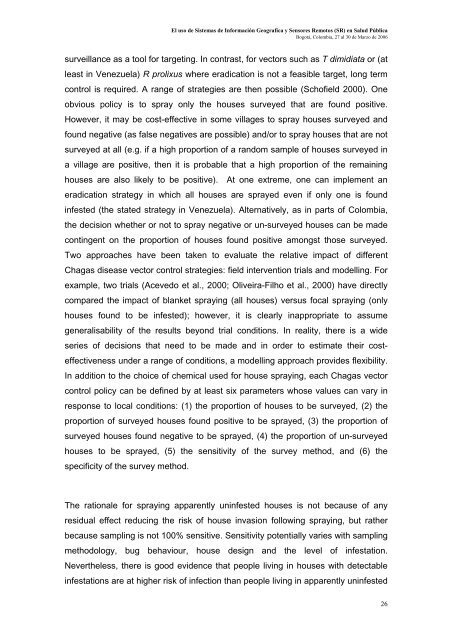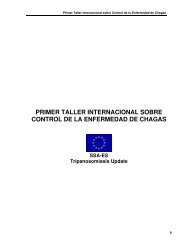El uso de Sistemas de Información Geográfica - CDIA-EC ...
El uso de Sistemas de Información Geográfica - CDIA-EC ...
El uso de Sistemas de Información Geográfica - CDIA-EC ...
You also want an ePaper? Increase the reach of your titles
YUMPU automatically turns print PDFs into web optimized ePapers that Google loves.
<strong>El</strong> <strong>uso</strong> <strong>de</strong> <strong>Sistemas</strong> <strong>de</strong> <strong>Información</strong> Geografica y Sensores Remotos (SR) en Salud Pública<br />
Bogotá, Colombia, 27 al 30 <strong>de</strong> Marzo <strong>de</strong> 2006<br />
surveillance as a tool for targeting. In contrast, for vectors such as T dimidiata or (at<br />
least in Venezuela) R prolixus where eradication is not a feasible target, long term<br />
control is required. A range of strategies are then possible (Schofield 2000). One<br />
obvious policy is to spray only the houses surveyed that are found positive.<br />
However, it may be cost-effective in some villages to spray houses surveyed and<br />
found negative (as false negatives are possible) and/or to spray houses that are not<br />
surveyed at all (e.g. if a high proportion of a random sample of houses surveyed in<br />
a village are positive, then it is probable that a high proportion of the remaining<br />
houses are also likely to be positive). At one extreme, one can implement an<br />
eradication strategy in which all houses are sprayed even if only one is found<br />
infested (the stated strategy in Venezuela). Alternatively, as in parts of Colombia,<br />
the <strong>de</strong>cision whether or not to spray negative or un-surveyed houses can be ma<strong>de</strong><br />
contingent on the proportion of houses found positive amongst those surveyed.<br />
Two approaches have been taken to evaluate the relative impact of different<br />
Chagas disease vector control strategies: field intervention trials and mo<strong>de</strong>lling. For<br />
example, two trials (Acevedo et al., 2000; Oliveira-Filho et al., 2000) have directly<br />
compared the impact of blanket spraying (all houses) versus focal spraying (only<br />
houses found to be infested); however, it is clearly inappropriate to assume<br />
generalisability of the results beyond trial conditions. In reality, there is a wi<strong>de</strong><br />
series of <strong>de</strong>cisions that need to be ma<strong>de</strong> and in or<strong>de</strong>r to estimate their cost-<br />
effectiveness un<strong>de</strong>r a range of conditions, a mo<strong>de</strong>lling approach provi<strong>de</strong>s flexibility.<br />
In addition to the choice of chemical used for house spraying, each Chagas vector<br />
control policy can be <strong>de</strong>fined by at least six parameters whose values can vary in<br />
response to local conditions: (1) the proportion of houses to be surveyed, (2) the<br />
proportion of surveyed houses found positive to be sprayed, (3) the proportion of<br />
surveyed houses found negative to be sprayed, (4) the proportion of un-surveyed<br />
houses to be sprayed, (5) the sensitivity of the survey method, and (6) the<br />
specificity of the survey method.<br />
The rationale for spraying apparently uninfested houses is not because of any<br />
residual effect reducing the risk of house invasion following spraying, but rather<br />
because sampling is not 100% sensitive. Sensitivity potentially varies with sampling<br />
methodology, bug behaviour, house <strong>de</strong>sign and the level of infestation.<br />
Nevertheless, there is good evi<strong>de</strong>nce that people living in houses with <strong>de</strong>tectable<br />
infestations are at higher risk of infection than people living in apparently uninfested<br />
26




